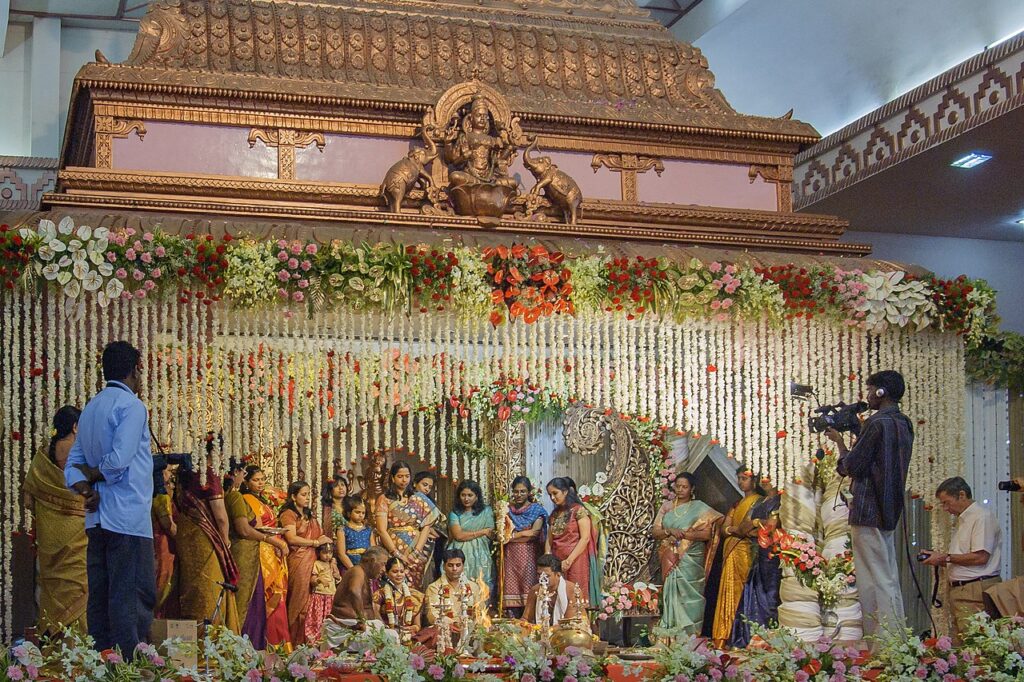Weddings: Perhaps a $100 Billion Industry in India Now
In brief, I describe Indian weddings with these 9 well-thought-out words and phrases: wonderful, worthwhile remembering, perhaps wearisome, elaborate, expensive, expressive, very delightful, stunningly decorative, and highly detailed.
Wonderful, worthwhile remembering, perhaps even wearisome:
Not only are Indian weddings wonderful with the prospect of meeting many relatives and friends you’ve not seen for a long while attending wearing with the finest saris and elegant suits, they are are truly worthwhile remembering with a plethora of events over numerous days.
To be honest, they could also be quite wearisome, with ceremonies lasting a whole week or longer. If the dates for some occasions are not quite as auspicious as determined by the priest, he can modify them, after consulting an astrological calendar checking compatibility characteristics of the couple and other aspects relating to their birth dates and other factors.
Elaborate, expensive, expressive
Indian weddings quite elaborate in the sequence of events, (with each event occurring on a separate day):
1.engagement ceremonies (which could be in two sequences: preliminary, followed by final ceremony)
2.mehndi (placement of henna by women on their hands),
3.wedding rituals performed by a priest, and final event 4.reception dinner for all attendees.
They are usually expensive (sometimes consuming a middle-income family’s several years’ of savings) or, as was the case of a wealthy Hong Kong-based couple I know of, whose daughter got married in California and spent around US500,000.
Perhaps the most expensive Indian wedding that I have read about was the wedding of Brahmani (daughter of mining mogul Gani Jannradhan Reddy) with Rajiv Reddy in November 2016. The function had around 50,000 guests and around 3,000 police officers for security purposes. Among other features, the wedding cards were gold-plated and fitted with LCD screens. The reported cost of this wedding as around $74 million, or nearly $1,500 per attendee. Read more about this mining mogul at: https://en.wikipedia.org/wiki/G._Janardhana_Reddy:
Another expensive wedding was that of another woman also named Brahmani, daughter of Mukesh and Nita Ambani. According to the Forbes and Bloomberg Billionaires Index, Mukesh Ambani is Asia’s second wealthiest person after Gautam Shantilal Adani, a port development and operations business owner worth $138 billion, according to Forbes Magazine. He is Asia’s wealthiest and also ranks as the world’s third wealthiest person, after Elon Musk and Bernard Arnault. Read more on Gautam Shatilal Adani; https://en.wikipedia.org/wiki/Gautam_Adani
The Ambanis are the world’s 8th wealthiest family, worth US$95.7 billion as of September 6, 2022. Mukesh Ambani is the Chairman and Managing Director of Reliance Industries, a steel-making company and highly diverse conglomerate, and a member of the Fortune Global 500: Read more at https://en.wikipedia.org/wiki/Mukesh_Ambani
Indian weddings are also uniquely expressive in their own ways, as some imaginative couples introduce some unusual features to make the total experience enthralling.
Delightful, decorative, detailed
And they are not only very delightful, creating long-term memories in people’s minds aided with videos and photo, they are also stunningly decorative, with highly colorful ceremonies based on Hindu beliefs and symbolisms, and highly detailed, with creative albums containing a chronology of events: the initial encounter, dates, engagement ceremony, the betrothal in front of God, blessings of relatives and their wishes for a blissful, long marriage, and much more.
Religious makeup of our world, in India, and weddings of different religious groups. Today (Oct. 01, 2022) per the Worldometer, there are, around the world, 7.98 billion people. Some 2.73 billion of them or 31.5% are Christians, 1.598 billion or 23.2% are Muslims, 1.101 billion or 15.5 % of people are with no religion, 1.033 billion or 15% are Hindus, 488 million or 7.1% are Buddhists, 405 million or 5.9 % are Folk Religionists, 58.1 million or 0.8% are of other religions, 26 million or 0.80% are Sikhs, and nearly 14 million or 0.2 % are Jews.
India has 1.367 billion people today (No.2 in the world in population) while No.1 being China has 1.452 billion people. These two most populated countries constitute more than a third or over 35 percent of the 7.98 billion people on earth.
In India today roughly 80 percent of its 1.367 billion people (1.0936 billion) are Hindus, 13 percent or 178 million are Muslims, 2.3 percent or 31.4 million are Christians, 1.9 percent or nearly 26 million are Sikhs, 0.80 percent or nearly 11 million are Buddhists, and 0.40 percent or nearly 547,000 people are Jains.
Most Indian nuptials are basically Hindu weddings, while the religious wedding ceremonies of Muslims, Sikhs, Christians, Buddhists, Jains and other faiths are similar in some ways but also different in other ways.
My own wedding was over 41 years ago in 1981 in Manila. I took an extended 4+ months (December 1980 to April 1981) break from work in New York. My elder brother’s wife introduced me to around two dozen prospects in Manila. They had a variety of physical and psychological characteristics, different interests and hobbies, etc. in life. None of them appealed to me except one, but she wanted to pursue a graduate degree. I was not going to wait two years, so I moved on in my search.
My sister-in-law spoke to a family friend in nearby Hong Kong who had a few prospects in mind for me to meet. But very first person I met there appealed to me. Her parents, particularly her father, asked me a whole lot of detailed questions pertaining to my habits, and more inquisitively, about my finances. I answered all questions plainly and simply. When the ‘matchmaker’ friend asked my sister-ln-law my decision about the woman who I met I simply said to my sister-in-law to tell the family-friend matchmaker that I want to get to know the prospect better over dinner.
t did not take me long to arrive at an affirmative decision. That was relayed to our Hong Kong family friend. After the appropriate date was set based on the priest’s astrological recommendations, (about four months into the future on April 19, 1981), I spent the rest of my vacation in Manila relaxing with old friends, classmates, and fraternity brothers..
For our wedding, we had around 1,000 invitees. Only 250 people (out of 500 invited) attended our wedding rituals with the priest at the Manila Hindu Temple.
But about 750 people (out of 500 people invited) attended our wedding reception at Manila Metro Club. My elder brother, a long-time Manila resident, had fortunately for-warned me about this possibility, so an appropriate number of dining seats were set, and an adequate amount of food had been prepared. The two events were one of my life’s happiest and most memorable ones.
In short, I spent the equivalent of what amounts to around $81,500 in today’s dollars. But the happiness I have today within all aspects of my family life with my lovely wife, our two sons and daughters-in-law, and our three grandchildren, a daughter, and soon-to-be son-in-law cannot be measured in monetary terms – it is truly priceless! I also love my work life of helping people improve their lives with the power of information that I provide with two websites I have, and various social media: Facebook, LinkedIn and Twitter.
Kumar (Kem) Balani is the Founder-Publisher of ASIA-AMERICA Online at www.Asia-America since May, 2022. He is also the Founder-Publisher of BIZ INDIA Magazine since June 2002, which, in 2011, went totally online as BIZ INDIA Online News at www.BIZINDIA.net








